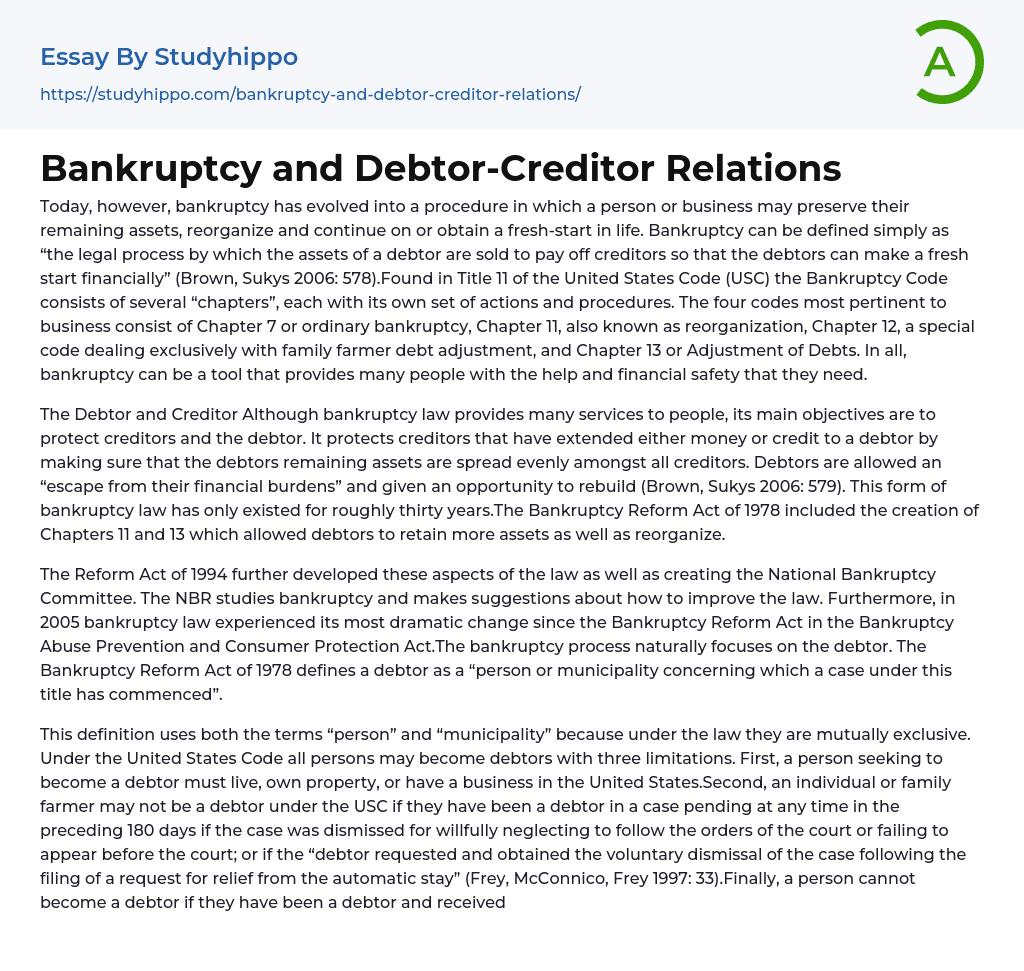Today, however, bankruptcy has evolved into a procedure in which a person or business may preserve their remaining assets, reorganize and continue on or obtain a fresh-start in life. Bankruptcy can be defined simply as “the legal process by which the assets of a debtor are sold to pay off creditors so that the debtors can make a fresh start financially” (Brown, Sukys 2006: 578).Found in Title 11 of the United States Code (USC) the Bankruptcy Code consists of several “chapters”, each with its own set of actions and procedures. The four codes most pertinent to business consist of Chapter 7 or ordinary bankruptcy, Chapter 11, also known as reorganization, Chapter 12, a special code dealing exclusively with family farmer debt adjustment, and Chapter 13 or Adjustment of Debts. In all, bankruptcy can be a tool that provides many people wi
...th the help and financial safety that they need.
The Debtor and Creditor Although bankruptcy law provides many services to people, its main objectives are to protect creditors and the debtor. It protects creditors that have extended either money or credit to a debtor by making sure that the debtors remaining assets are spread evenly amongst all creditors. Debtors are allowed an “escape from their financial burdens” and given an opportunity to rebuild (Brown, Sukys 2006: 579). This form of bankruptcy law has only existed for roughly thirty years.The Bankruptcy Reform Act of 1978 included the creation of Chapters 11 and 13 which allowed debtors to retain more assets as well as reorganize.
The Reform Act of 1994 further developed these aspects of the law as well as creating the National Bankruptcy Committee. The NBR studies bankruptc
and makes suggestions about how to improve the law. Furthermore, in 2005 bankruptcy law experienced its most dramatic change since the Bankruptcy Reform Act in the Bankruptcy Abuse Prevention and Consumer Protection Act.The bankruptcy process naturally focuses on the debtor. The Bankruptcy Reform Act of 1978 defines a debtor as a “person or municipality concerning which a case under this title has commenced”.
This definition uses both the terms “person” and “municipality” because under the law they are mutually exclusive. Under the United States Code all persons may become debtors with three limitations. First, a person seeking to become a debtor must live, own property, or have a business in the United States.Second, an individual or family farmer may not be a debtor under the USC if they have been a debtor in a case pending at any time in the preceding 180 days if the case was dismissed for willfully neglecting to follow the orders of the court or failing to appear before the court; or if the “debtor requested and obtained the voluntary dismissal of the case following the filing of a request for relief from the automatic stay” (Frey, McConnico, Frey 1997: 33).Finally, a person cannot become a debtor if they have been a debtor and received a discharge, which is essentially the wiping away of a person’s debts, within the past six years.
Creditors, along with making sure that the debtor’s assets are distributed evenly, want to “assure that the debtor does not receive a discharge unless one is justified and that the debts are nondischargeable according to law are not discharged through the bankruptcy proceeding. Within these priorities creditors hold three basic
types of claims: priority, secured, and unsecured.Priority claims include those made by employees for employee compensation, claims for alimony, claims made by the IRS, and claims made by the state tax commission, Secured claims are secured by personal property or real estate. Property is also known as collateral and may be taken by the creditor if the debtor did not fulfill their obligation to pay the debt. Unsecured claims are those that are not secured by collateral.
Chapter 7: Liquidation or Straight Bankruptcy
Also known as “straight” or “liquidation” bankruptcy this form of bankruptcy is generally best suited to people with a modest income, few assets, and comparatively high debts and allows for the discharge of most debts (American Bar Association 2006: 219). It is worth noting that although liquidation of the debtor is the primary function of Chapter 7, liquidation may also occur under other chapters. Chapter 11 may provide for liquidation of some or all of a debtor’s assets. Nonetheless, Chapter 7 is the only chapter that deals specifically with liquidation in which “a trustee gathers up the debtor’s assets, sells them, and generally makes a one-time distribution to creditors”.
However, Chapter 7 does not require an immediate “fire sale” of the debtor’s assets; in appropriate circumstances a Chapter 7 trustee may decide upon an extended liquidation or even continue to run a debtor’s business for a period (Herbert 1995: 291). Chapter 7 cases represent the bulk of original bankruptcy cases filed.Roughly 70 percent of bankruptcy filings nationwide are Chapter 7 cases (American Bar Association 2006: 219). In addition to these original filings, many Chapter 11 and 13 cases will convert to Chapter 7. Given the
more stringent codes of the Bankruptcy Abuse Prevention and Consumer Protection Act of 2005, however, it remains to be seen whether so many people will continue to file for Chapter 7.
- Bank essays
- Banking essays
- Corporate Finance essays
- Credit Card essays
- Currency essays
- Debt essays
- Donation essays
- Enron Scandal essays
- Equity essays
- Financial Accounting essays
- Financial Crisis essays
- Financial News essays
- Financial Ratios essays
- Financial Services essays
- Forecasting essays
- Foreign Exchange Market essays
- Free Market essays
- Gold essays
- Investment essays
- Legacy essays
- Loan essays
- Market Segmentation essays
- Money essays
- Personal finance essays
- Purchasing essays
- Retirement essays
- Shareholder essays
- Stock Market essays
- Supply And Demand essays
- Venture Capital essays
- Bankruptcy essays
- Earnings essays
- Premise essays
- S corporation essays
- Secretary essays
- Tata Group essays




